Anabolism vs catabolism is a topic that intrigues many health enthusiasts. These two terms sound complex, but they describe fundamental ways your body processes energy. Anabolism is about building up, while catabolism is about breaking down. Both help you thrive. When you eat a balanced diet and stay hydrated, you support your body’s natural cycles of construction and repair. Without the right macronutrient balance and lifestyle, you might slip too far into a catabolic state, which can lead to muscle loss and low energy.
In this article, we will explore the difference between anabolism and catabolism, how they interact, and why they matter for everyday health. We will discuss how hormones, vitamin D, and exercise play a role in these processes. You will learn practical tips for supporting muscle growth, optimizing energy, and staying balanced. If you want to understand what drives muscle gain, weight loss, and overall vitality, this simple guide is here to help. Get ready to discover how to fine-tune your body’s inner machinery and feel your best.
1. Understanding Anabolism
Anabolism refers to your body’s capacity to build and grow. This process is essential for creating new cells, repairing tissues, and synthesizing proteins. Think of it as a constructive phase. When you engage in strength training and consume the right macronutrient balance, especially protein, you enhance anabolic pathways. This helps your muscles grow and recover.
Hormones such as insulin and growth hormone support anabolism (PubMed Central, 2021). These signals tell your cells to absorb nutrients and form new structures. For instance, after a workout, insulin helps shuttle amino acids into muscle cells, sparking growth. If you do not eat enough protein or healthy carbohydrates, your body may not receive the fuel needed to sustain anabolism.
Another key factor in anabolism is getting enough vitamin D. This nutrient supports bone formation and muscle function. Insufficient vitamin D levels can slow bone repair and leave you feeling weak (Harvard Health, 2020). Pair that with a lack of balanced diet habits, and you might miss out on crucial nutrients that enable muscle synthesis.
Maintaining an anabolic edge is not about stuffing yourself with food. Instead, it’s about timing your meals, choosing nutrient-rich items, and focusing on regular, sensible exercise. By supplying your body with the building blocks it needs—and making sure to hydrate—you can nudge your system toward growth, strength, and resilience.

2. Understanding Catabolism
Catabolism is often described as the breakdown phase of metabolism. In this state, your body tears down molecules to release energy. While this might sound negative, catabolism is vital for everyday life. Without it, you would not have the energy to move, think, or even breathe. During catabolic reactions, complex molecules like glycogen and proteins split into smaller units, providing the fuel your cells need.
A common example is fasting. When you do not eat for several hours, your body transitions to a more catabolic state, breaking down stored glycogen or even muscle protein for energy. Athletes who train in the morning on an empty stomach can experience elevated catabolism, which might help with fat loss but can also risk muscle breakdown. This is where balancing anabolism vs catabolism becomes important.
Certain hormones, such as cortisol, help drive catabolism (Cleveland Clinic, 2021). High levels of stress can elevate cortisol and increase the rate at which your body breaks down tissues. For health enthusiasts, recognizing this balance is key. If you frequently engage in intense workouts without allowing proper recovery, you may stay in a catabolic loop.
Catabolism has a purpose, but when it dominates, it can hamper muscle growth and overall vitality. Maintaining a balanced diet, ensuring you hydrate, and including rest days can keep catabolism in check, allowing your body to restore itself.
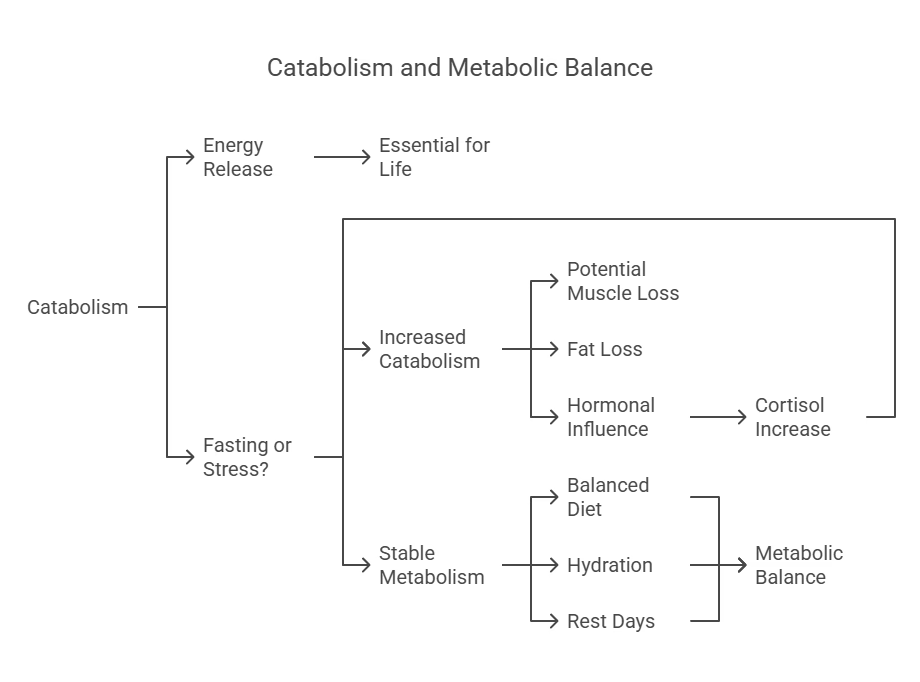
3. Balancing Anabolism and Catabolism
Striking the right balance between anabolism vs catabolism is critical for optimal health. Your body performs both processes constantly, but leaning too far in one direction can create issues. If you focus solely on anabolism without allowing any breakdown, you could accumulate excess fat. On the other hand, prolonged catabolism can lead to muscle loss, weakened bones, and depleted energy.
An effective way to manage this balance is through macronutrient ratios. Proteins, carbohydrates, and fats each play unique roles in metabolic health (Medical News Today, 2020). Protein supports muscle repair and growth, carbohydrates provide immediate energy for workouts, and healthy fats regulate hormones. By tuning your ratios, you ensure your body has the resources it needs for both building and breaking down as needed.
Timing is another factor. Many fitness enthusiasts use strategies like nutrient timing—eating protein and carbohydrates soon after exercise—to amplify anabolic signals and limit catabolic damage. Meanwhile, fasting or reduced-calorie days can help your body shed unwanted fat through catabolic pathways.
Consistency is key. Day-to-day habits like getting sufficient sleep, minimizing stress, and avoiding extreme dieting can keep your metabolism steady. By listening to your body and adapting your balanced diet and exercise routine, you can align anabolism and catabolism so that both contribute to your overall wellbeing.
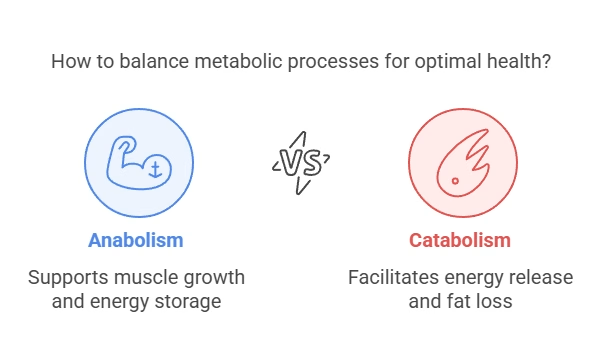
4. The Role of Diet and Lifestyle
Diet and lifestyle choices shape how anabolism vs catabolism operate in your body. If you load up on nutrient-poor foods and skip regular exercise, you set the stage for metabolic imbalances. On the flip side, a balanced diet with lean proteins, whole grains, fruits, and vegetables fosters a steady flow of building blocks.
One crucial factor is ensuring adequate vitamin D. Known for supporting bone health, vitamin D also helps muscles function properly (Healthline, 2019). Low levels can tilt your body toward catabolism, making muscle maintenance harder. Sunlight is a natural source of vitamin D, but diet and supplements can fill in gaps.
Hydration is another piece of the puzzle. When you hydrate well, you maintain optimal cellular function. Dehydration can contribute to increased protein breakdown, as your body struggles to perform normal repair processes. Even mild dehydration can lead to fatigue and impair performance.
Lifestyle factors matter too. Chronic stress raises cortisol, a hormone that promotes catabolic activity. Prioritizing activities like meditation, gentle yoga, or consistent sleep can help counterbalance catabolic forces. Meanwhile, resistance training sessions a few times a week can promote anabolic growth by signaling your body to adapt and build muscle.
By making conscious diet and lifestyle choices, you can tip the scale in favor of a healthy equilibrium that supports daily energy and long-term resilience.
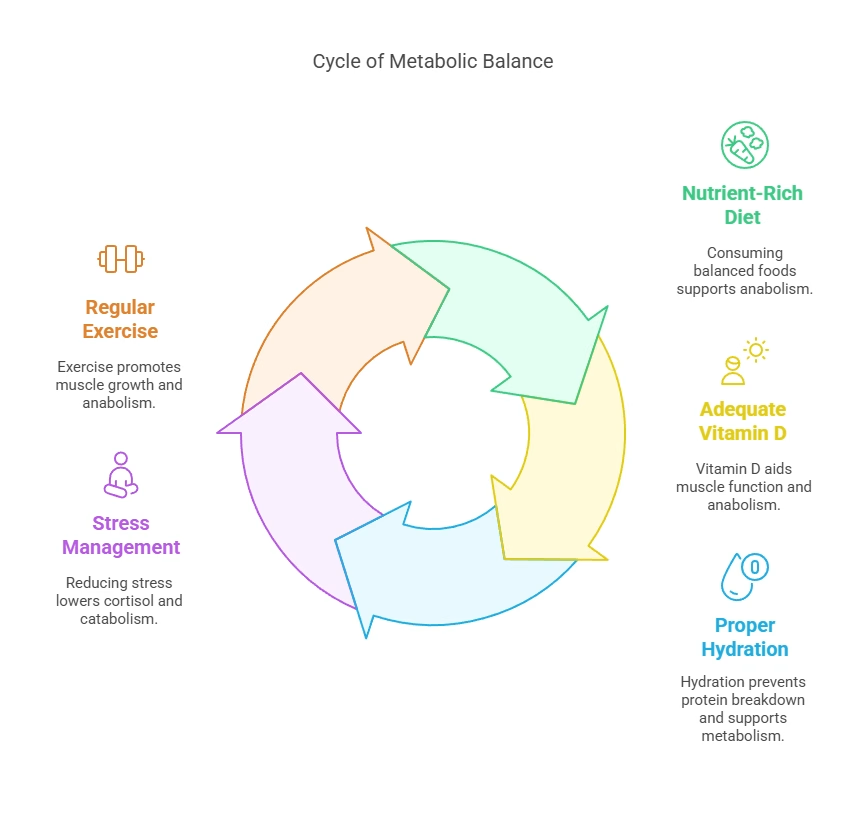
5. Practical Tips for Health Enthusiasts
For health enthusiasts, anabolism vs catabolism is not just an abstract concept—it’s the basis of progress in fitness and wellbeing. Here are some simple, actionable tips to keep you on track:
- Include Protein at Every Meal
Eat protein sources such as lean meats, beans, or tofu. This supports anabolic muscle repair while preventing your body from leaning too heavily on muscle proteins for fuel. - Balance Your Macronutrients
Make sure your plate features carbohydrates, fats, and proteins in each meal. A typical ratio might include 40% carbs, 30% protein, and 30% fat. Adjust this to suit your workout intensity and personal goals. - Use Nutrient Timing Wisely
Consume a post-workout meal with protein and carbs. This signals your muscles to enter an anabolic phase and replenish energy stores. - Stay Hydrated
Water is crucial for transporting nutrients, maintaining cellular function, and preventing excessive breakdown. Aim for at least 2 liters a day, and more if you exercise intensely. - Support Your Body with Vitamin D
Whether through sunlight, fortified foods, or supplements, make sure you have enough vitamin D to support bone and muscle health. - Manage Stress
High stress can trigger catabolic hormones like cortisol. Practice mindfulness, get enough sleep, and engage in relaxing hobbies to keep cortisol at bay.
Following these steps will help you maintain the delicate dance between anabolism and catabolism while fostering a robust, energetic body.
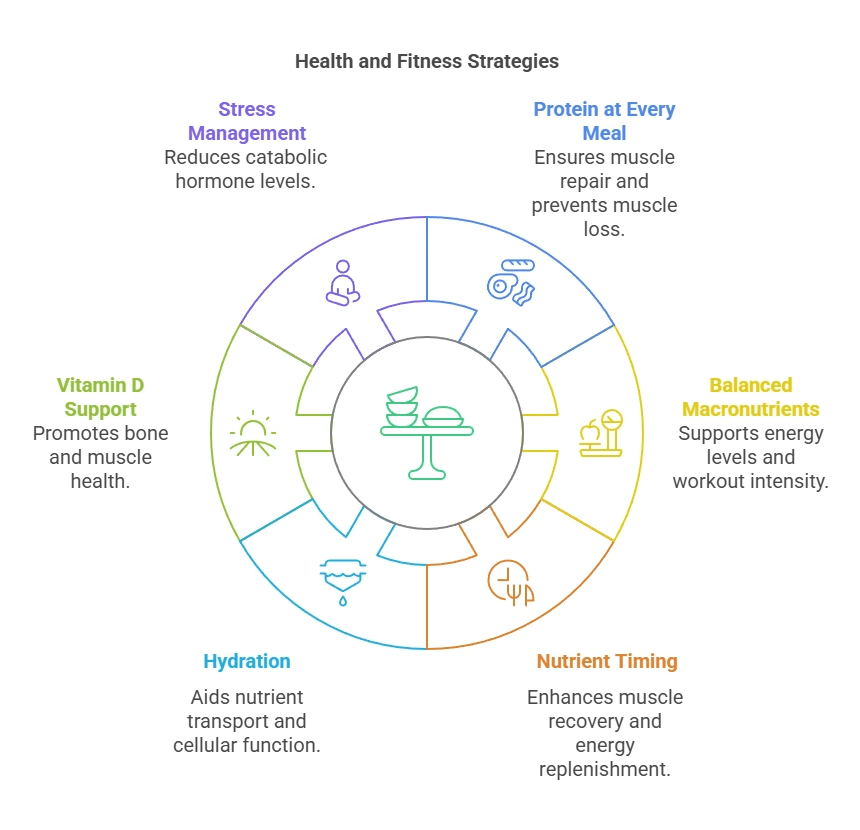
6. A Unique Perspective—The Hormonal Influence
Many articles on anabolism vs catabolism focus on diet and exercise. Yet hormones are the silent drivers that determine how efficiently you build muscle or break down tissues. Consider insulin. It’s often labeled a “storage hormone,” but it also facilitates nutrient uptake into cells, making it a powerful anabolic agent when managed well. Athletes with precise insulin timing can optimize protein synthesis while controlling fat gain.
Another potent hormone is growth hormone (GH). Released in pulses during sleep, GH triggers muscle repair and promotes fat metabolism. This dual action helps shift your body toward net anabolism overnight (Lumen Learning, 2020). That’s why consistent, quality sleep is non-negotiable if you want to grow stronger and leaner.
On the catabolic side, cortisol stands out. Often called the “stress hormone,” cortisol ensures that your body has enough energy to handle emergencies. But if stress becomes chronic, cortisol remains elevated, nudging the body into a state of breakdown. This can weaken immune function and degrade muscle tissue.
By monitoring lifestyle factors—sleep patterns, stress levels, and meal timing—you gain an edge in balancing these hormones. Small changes, like a regular bedtime or brief relaxation techniques, can significantly reduce catabolic signals while amplifying anabolic ones. When you pay attention to your hormones, you unlock a powerful tool for influencing your body’s build-or-break cycle.
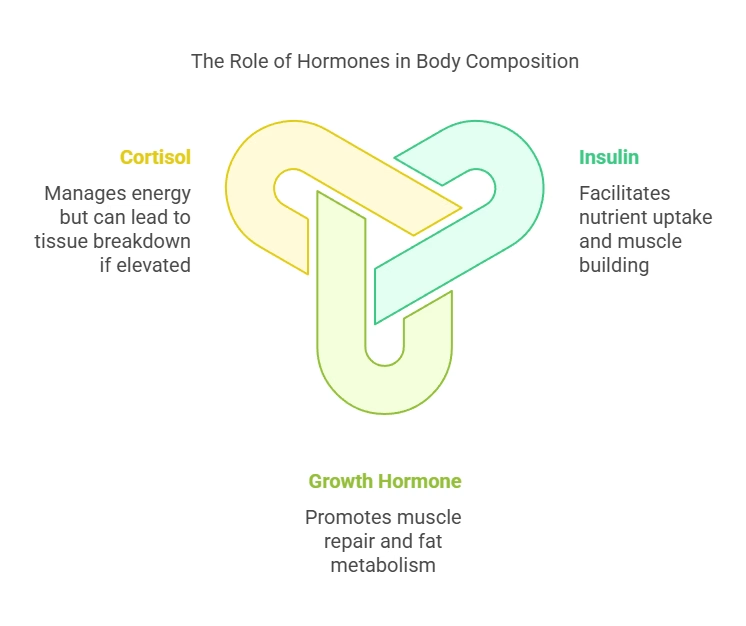
Quick Takeaways
- Anabolism builds; catabolism breaks down. Both processes are essential for energy and growth.
- A balanced diet with proper macronutrient ratios fuels anabolism and limits excessive catabolism.
- Vitamin D and consistent hydration support muscle function and overall metabolic balance.
- Hormones like insulin and growth hormone promote anabolism, while cortisol drives catabolism.
- Fasting can boost fat burning (catabolism), but it must be balanced with adequate protein to prevent muscle loss.
- Stress management and quality sleep are crucial for reducing catabolic signals.
- Simple changes in meal timing, nutrient intake, and exercise can tip the balance toward a healthier state.
Conclusion
Anabolism vs catabolism underpins how your body repairs tissues, maintains energy, and adapts to daily challenges. By now, you’ve learned that anabolism builds things up—key for muscle strength, bone integrity, and general rejuvenation. Catabolism breaks things down, ensuring your body has enough energy to function. Though these processes may seem at odds, they actually work in tandem to keep you healthy and resilient.
Balancing these two forces starts with your balanced diet. Think about focusing on the macronutrient mix that suits your lifestyle, whether that means more protein if you lift weights or slightly higher carbohydrates if you’re an endurance athlete. Supporting nutrients like vitamin D also play an important role, aiding bone health and muscle recovery. Staying hydrated helps your cells operate smoothly, limiting the stress on your system.
Additionally, remember the influence of hormones. If cortisol is high from chronic stress, you could be in a heightened catabolic state. If insulin and growth hormone are managed well through proper nutrition, rest, and moderate exercise, your body benefits from anabolic repair and growth.
In the end, it’s about harmony. By making intentional choices—mindful eating, consistent training, stress reduction—you guide your body toward a healthy balance of anabolism and catabolism, laying the foundation for long-term vitality.
Frequently Asked Questions
1. Why is balancing anabolism vs catabolism important?
Balancing anabolism vs catabolism helps you maintain muscle, strength, and energy levels. Too much catabolism can lead to muscle loss, while excessive anabolism can cause fat gain or other imbalances.
2. How can I support anabolism if I work out often?
Consume protein-rich foods and maintain a balanced diet. Don’t forget to hydrate and include healthy carbs post-workout. Ensuring enough vitamin D also supports muscle function and growth.
3. Does fasting always put me in a catabolic state?
Fasting triggers catabolism to burn stored energy. Short fasting windows can help reduce excess fat, but long-term fasting or severe calorie restriction can break down muscle if not balanced with adequate protein intake.
4. What role do hormones play in anabolism vs catabolism?
Hormones like insulin and growth hormone promote anabolism. Cortisol and adrenaline lean toward catabolism. Balancing these hormones through stress management, sleep, and sensible eating can optimize your results.
5. Are carbs necessary for anabolic processes?
Yes. Carbohydrates help replenish muscle glycogen, allowing faster recovery. A moderate amount of carbs can support muscle repair and growth without pushing you into a prolonged catabolic state.
References
- Harvard Health. (2020). Vitamin D and Your Bones. Retrieved from [Harvard Health Publishing]
- Cleveland Clinic. (2021). Metabolism 101: How Your Body Processes Food. Retrieved from [Cleveland Clinic Website]
- Healthline. (2019). The Importance of Vitamin D. Retrieved from [Healthline]
- Lumen Learning. (2020). Metabolic Pathways and Energy Balance. Retrieved from [Lumen Learning Online Resources]
- Medical News Today. (2020). Macronutrients and Their Role in Health. Retrieved from [MNT Website]
